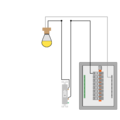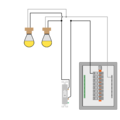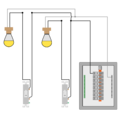Difference between revisions of "Wiring basic load circuits"
Jump to navigation
Jump to search
| (6 intermediate revisions by the same user not shown) | |||
| Line 1: | Line 1: | ||
[[Category:System installation]] | [[Category:System installation]] | ||
| − | Lighting and load circuits are can be easily wired using [[ | + | <languages /> |
| + | <translate> | ||
| + | <!--T:1--> | ||
| + | Lighting and load circuits are can be easily wired using [[Special:MyLanguage/Conductor types|wires]], [[Special:MyLanguage/Twist-on wire connector|twist-on wire connectors]], [[Special:MyLanguage/Switch|switches]] and [[Special:MyLanguage/Outlet|outlets]]. The wiring for both alternating current and direct current circuits is similar. For both types of current [[Special:MyLanguage/Grounding system|ungrounded conductors]] should be switched rather than [[Special:MyLanguage/Grounding system|grounded conductors]]. If the system is ungrounded then it does not matter, although a convention should be followed. DC wiring must be installed carefully to respect [[Special:MyLanguage/Electricity and energy|polarity]] to ensure no short circuits or damage to lighting. [[Special:MyLanguage/Insulation color|Insulation color conventions]] should always be respected. | ||
| − | In the diagrams below, the dots represent connections (typically made with [[Twist-on wire connector|twist-on wire connectors]]). The [[Grounding system|equipment grounding conductor (EGC) is not included for simplicity. | + | <!--T:2--> |
| + | In the diagrams below, the dots represent connections (typically made with [[Special:MyLanguage/Twist-on wire connector|twist-on wire connectors]]). The [[Special:MyLanguage/Grounding system|equipment grounding conductor (EGC)]] is not included for simplicity. | ||
| + | <!--T:3--> | ||
<gallery widths=200px> | <gallery widths=200px> | ||
| − | File: | + | File:Circuit1bulb210103.png|A circuit with 1 light bulb operated by one switch. |
| − | File: | + | File:Circuit2bulb210103.png|A circuit with 2 lightbulbs operated by one switch. |
| − | File: | + | File:Circuit2light2switch210103.png|A circuit with 2 light bulbs operated by two separate switches. |
</gallery> | </gallery> | ||
| + | |||
| + | ==Notes/references== <!--T:4--> | ||
| + | </translate> | ||
Latest revision as of 10:32, 22 February 2021
Lighting and load circuits are can be easily wired using wires, twist-on wire connectors, switches and outlets. The wiring for both alternating current and direct current circuits is similar. For both types of current ungrounded conductors should be switched rather than grounded conductors. If the system is ungrounded then it does not matter, although a convention should be followed. DC wiring must be installed carefully to respect polarity to ensure no short circuits or damage to lighting. Insulation color conventions should always be respected.
In the diagrams below, the dots represent connections (typically made with twist-on wire connectors). The equipment grounding conductor (EGC) is not included for simplicity.


